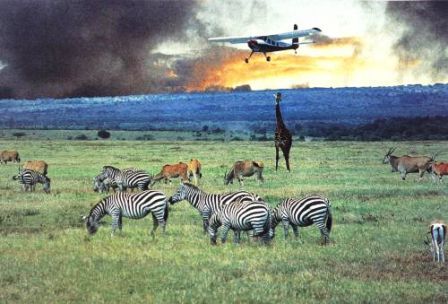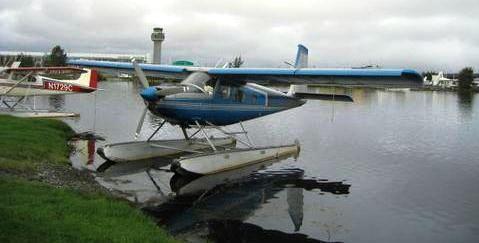Helio Courier
The Helio Courier was produced in several different versions from 1954. In modern times the Courier has been produced in limited batches and is reputedly currently close to being produced again. Very few planes offered the STOL performance of the Helio Courier and the only practical alternative for those seeking better STOL performance are helicopters. Helios comfortably seat four adults, though some models featured seating for six. Like the
Cessna 180 and 185, the last two seats were small and cramped and generally not feasible for hauling adults.

Helios have a distinguished and storied history, and several were used in covert operations during the Viet Nam conflict. Exactly what role these planes were utilized in during the conflict is the subject that remains somewhat poorly told. Often stories of the Helio’s role in the conflict smell remarkably of fiction, but their use in covert operations is undisputed. Air America operated Helios during the conflict.
Tangentially on point, one tired night, in the midst of a discussion about the Helio's history, my sleep-deprived wife said the Helio were used in the "missionary position". Then she paused, busted out laughing and corrected her statement to mean "religious mission". The second version of her statement is correct. Helios have also been widely used by religious missionaries traveling in remote and exotic locations because of the Helio's superior STOL capabilities.

Helios were never produced in great numbers and are not as common in the bush as the Super Cubs and Cessna. Bush pilots that have Helios typically are very proud of their rare bird and can be quite possessive of them. One should not expect to easily rent or fly a Helio to “see what they’re like”.
Many Helios feature geared Lycoming engines and while these engines can be reliable if properly operated, they are notoriously finnicky and intolerant of ham-fisted pilots. One is well advised to have his or her financial affairs well in order when it comes time to overhaul these engines; few shops can properly service these engines and those that do, are not cheap. Given the foregoing, it is easy to appreciate the fact that Helios do not liberally dot the skies of bush country.
Once one goes beyond the negative aspects of the Helios, he or she quickly becomes aware of the outstanding characteristics of the aircraft. The wing of the Helio features an automatic, Handley-Page slot, which deploys when the aircraft is flown at slow speed. Once the airplane exceeds approximately 55-60 mph (depending upon conditions) the slats automatically retract. Sometimes a noticeable “bang” can be heard as the slats deploy or retract, and can be startling to pilots or passengers unaccustomed to them. Although the slats may be disconcerting to neophytes, they allow the Courier to be flown at speeds as low as 28 mph.
Under some conditions, the Helio can turn in the air at a radius not exceeding its wingspan, something perhaps no other airplane can do. Once again, the only feasible alternative to a Helio is a helicopter. A large rudder and vertical surface provides good control at very slow speeds, however, they can make the Helio difficult to handle in cross-wind conditions. Cross wind, castering landing gear is featured on some Helios.
 Some may recognize the tower at Ted Stevens International Airport in Anchorage, Alaska rising above the blue Helio on floats at Lake Hood.
Some may recognize the tower at Ted Stevens International Airport in Anchorage, Alaska rising above the blue Helio on floats at Lake Hood.Helios featured a robust welded steel tube fuselage with aluminum skin. The wings are constructed in semi-monocoque design of sheet aluminum. Because of the Helios ability to fly at very slow speeds coupled with its rugged steel tube fuselage, the plane is extremely crashworthy.
Helios are typically equipped with geared Lycoming engines but some models feature direct drive engines. A turboprop powered derivative of the Helio was manufactured as the Helio Stallion, these aircraft are exceedingly rare. Piston powered versions had engines that produce 250-400 hp.
Helios can be fitted with floats or skis, and some were made (or modified) to have tricycle landing gear. Helios on tricycle gear have an ungainly appearance, looking somewhat like a Tri-Pacer on evil steroids.
See the video for an impressive Helio take off.
This next short video cllip features an impressive Helio landing.
This next video features a cockpit view of a Helio flight with some impressive scenery.
Helio Fan Club
Joe from the United States says his dream plane is a new Helio Courier on Amphibs. Beau from the United States, who has been flying about a year, voted the Helio Stallion as his dream plane, but not the "best" bush plane. He had this to say, "There is no best. It depends on location." Interestingly, Beau works for Airframes Alaska where they work on Super Cubs.
Carl Rangel, from Antarctica, who has been flying over 20 years says the Helio Courier is the best bush plane. He also says his dream plane is the Scottish Aviation Pioneer.
John from the U.S. says, "the best bush plane is the Helio Courier (to bad it is so rare) second is the DeHavilland Beaver." John also let us know he would like more information about the Bearhawk.
Now here at bush-planes.com we are of the opinion that if money were no object, Helio is right up there with the best bush planes. But, having said that, and considering the engines are maintenance hogs, we believe a pilot could get just as much utility out of a Cessna 185 for half the price. But, no plane out there is going to pop on and off the ground like a Helio.
One of our pilots said, "It's the very best single engine STOL plane out there, hands down, although the slats on the leading edge of it's wings are maintenance issues."
Yet, another one of our bush pilots, let's call him Rudder Snob, said, "The Helio rudder is too big!"
Do you agree or disagree? Let us know here.
Jerry Waddell, from the United States, who has been flying over 30 years, agrees there is no best bush plane for all needs. Jerry, by the way, manufactures Angel Aircraft and would like to see his plane featured on this web site. He says his dream plane is the Angel Aircraft Model 44 and has invited us to his website to learn more about it. Despite the shameless self-promoting, we admire anyone who gets to realize the dream of manufacturing their own aircraft. So, Jerry, if you will contact us to arrange a test flight we can see about featuring your aircraft on our site.
As a follow up for Jerry, we have had a lot more requests to feature your Angel Aircraft on bush-planes.com after your post came in and so we are working on it. For anyone else who is interested in learning more about Angel Aircraft, we have posted a link to the Angel Aircraft brochure. I have to admit, it is a nice looking plane, but that should be expected when the price tag is upwards of $750,000.